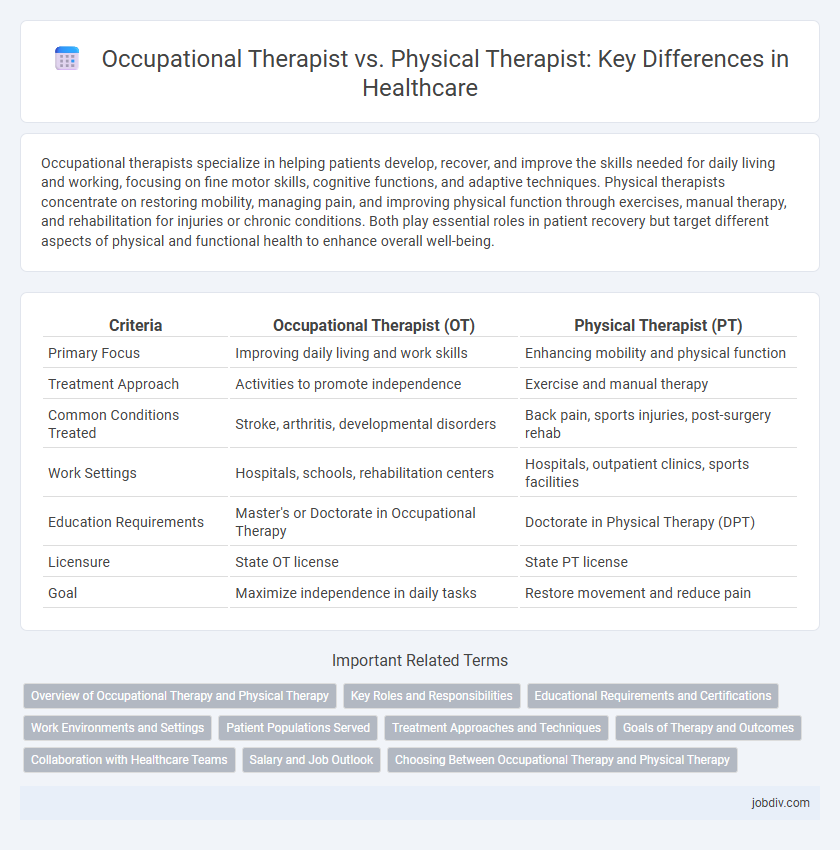Occupational therapists specialize in helping patients develop, recover, and improve the skills needed for daily living and working, focusing on fine motor skills, cognitive functions, and adaptive techniques. Physical therapists concentrate on restoring mobility, managing pain, and improving physical function through exercises, manual therapy, and rehabilitation for injuries or chronic conditions. Both play essential roles in patient recovery but target different aspects of physical and functional health to enhance overall well-being.
Table of Comparison
| Criteria | Occupational Therapist (OT) | Physical Therapist (PT) |
|---|---|---|
| Primary Focus | Improving daily living and work skills | Enhancing mobility and physical function |
| Treatment Approach | Activities to promote independence | Exercise and manual therapy |
| Common Conditions Treated | Stroke, arthritis, developmental disorders | Back pain, sports injuries, post-surgery rehab |
| Work Settings | Hospitals, schools, rehabilitation centers | Hospitals, outpatient clinics, sports facilities |
| Education Requirements | Master's or Doctorate in Occupational Therapy | Doctorate in Physical Therapy (DPT) |
| Licensure | State OT license | State PT license |
| Goal | Maximize independence in daily tasks | Restore movement and reduce pain |
Overview of Occupational Therapy and Physical Therapy
Occupational therapy focuses on enabling individuals to perform daily activities and improving fine motor skills through customized interventions that address physical, cognitive, and emotional challenges. Physical therapy emphasizes restoring mobility, strength, and function by treating musculoskeletal injuries, neurological conditions, and chronic pain using exercises, manual therapy, and modalities. Both therapies are integral in rehabilitation, with occupational therapy enhancing independence in everyday tasks and physical therapy optimizing physical movement and preventing disability.
Key Roles and Responsibilities
Occupational therapists focus on enhancing patients' daily living and work skills through therapeutic activities tailored to improve fine motor skills, cognitive functions, and adaptive techniques. Physical therapists specialize in restoring mobility, reducing pain, and preventing physical disabilities by designing exercise programs and manual therapy targeting muscles, bones, and joints. Both professionals collaborate closely in rehabilitation but address different aspects of patient recovery to optimize overall functional independence.
Educational Requirements and Certifications
Occupational therapists (OTs) typically require a master's or doctoral degree in occupational therapy and must pass the National Board for Certification in Occupational Therapy (NBCOT) exam to become licensed. Physical therapists (PTs) must earn a Doctor of Physical Therapy (DPT) degree and pass the National Physical Therapy Examination (NPTE) for licensure. Both professions demand continuing education to maintain certification and stay current with healthcare practices.
Work Environments and Settings
Occupational therapists often work in diverse settings such as hospitals, schools, rehabilitation centers, and clients' homes to help individuals develop or regain daily living and work skills. Physical therapists primarily practice in hospitals, outpatient clinics, sports facilities, and nursing homes, focusing on improving patients' mobility and physical function. Both professionals collaborate within interdisciplinary healthcare teams but differ in their specific work environments based on therapy goals and patient needs.
Patient Populations Served
Occupational therapists primarily serve patients with physical, developmental, or cognitive impairments that affect daily living and work skills, including individuals recovering from strokes, traumatic brain injuries, or those with autism spectrum disorders. Physical therapists focus on patients experiencing musculoskeletal injuries, neurological conditions, or mobility limitations, such as those recovering from orthopedic surgeries, sports injuries, or chronic pain conditions like arthritis. Both professions play crucial roles in rehabilitation but target different aspects of patient care, with occupational therapists emphasizing functional independence and physical therapists concentrating on movement and strength restoration.
Treatment Approaches and Techniques
Occupational therapists focus on helping patients regain daily living and work skills through activities that improve coordination, strength, and cognitive function, often incorporating adaptive equipment and environmental modifications. Physical therapists emphasize restoring physical mobility, strength, and pain reduction using techniques such as manual therapy, therapeutic exercises, and modalities like ultrasound or electrical stimulation. Both professionals collaborate to tailor individualized treatment plans that address patients' specific functional goals but differ in their primary therapeutic objectives and intervention methods.
Goals of Therapy and Outcomes
Occupational therapists focus on improving patients' ability to perform daily living activities and regain independence through targeted interventions tailored to individual functional goals. Physical therapists prioritize restoring mobility, strength, and physical function, aiming to reduce pain and prevent disability through movement-based treatments. Both therapies contribute to enhanced quality of life, with occupational therapy emphasizing adaptive skills and physical therapy emphasizing physical recovery and rehabilitation outcomes.
Collaboration with Healthcare Teams
Occupational therapists and physical therapists collaborate closely with healthcare teams to enhance patient outcomes through complementary expertise. While occupational therapists focus on improving patients' ability to perform daily activities and regain functional independence, physical therapists emphasize restoring mobility, strength, and physical function. Their integrated approach ensures comprehensive rehabilitation, addressing both physical recovery and practical skill adaptation within multidisciplinary care plans.
Salary and Job Outlook
Occupational therapists earn a median annual salary of around $86,000, while physical therapists typically make about $95,000, reflecting variations in demand and specialization across healthcare settings. Job outlook for both professions is strong, with physical therapy projected to grow 18% and occupational therapy growing 17% from 2022 to 2032, driven by aging populations and increased focus on rehabilitation. Employment opportunities for occupational therapists often arise in mental health and pediatric care, whereas physical therapists frequently find roles in sports medicine and orthopedics.
Choosing Between Occupational Therapy and Physical Therapy
Choosing between occupational therapy and physical therapy depends on specific rehabilitation goals; occupational therapy focuses on improving daily living skills and fine motor functions, while physical therapy emphasizes restoring movement, strength, and physical mobility. Patients recovering from surgery or injury involving muscles and joints often benefit from physical therapy, whereas those needing assistance with cognitive or sensory processing and adapting to disabilities typically require occupational therapy. Determining the most effective treatment involves consulting healthcare professionals to evaluate the individual's physical condition and desired outcomes.
Occupational Therapist vs Physical Therapist Infographic

 jobdiv.com
jobdiv.com